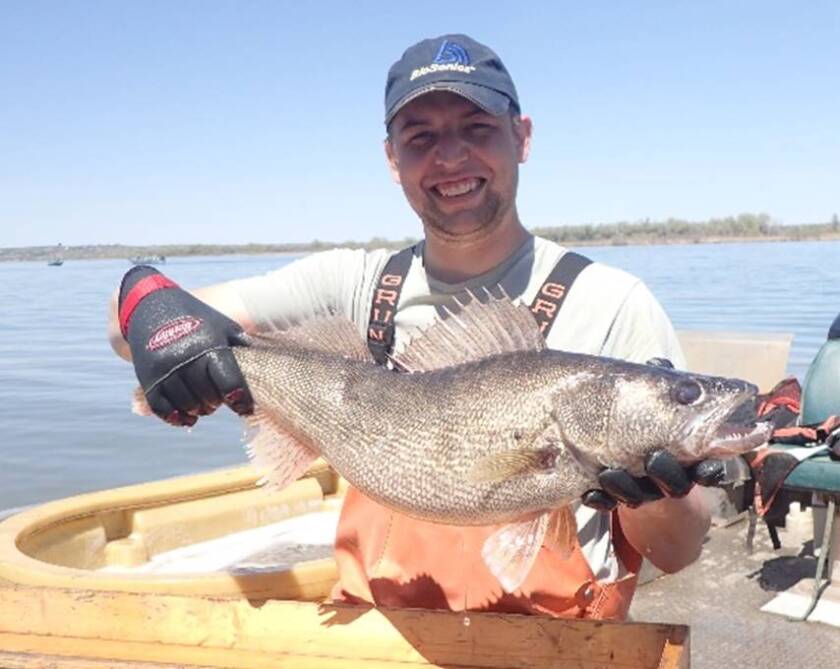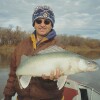GRAND FORKS -- They can live a long time – more than 100 years, studies have shown – they can grow to gargantuan proportions and they’re a popular target of bowfishing enthusiasts on lakes and rivers in the Red River Basin.
They’re also a species of fascination.
That, in a nutshell, describes the bigmouth buffalo, a native fish species in Minnesota and North Dakota that has gained notoriety since North Dakota State University researcher Alec Lackmann documented a specimen in 2019 that was 112 years old from the Pelican River, a Red River Basin tributary of the Otter Tail River in northwest Minnesota.
It’s the oldest fish ever documented in Minnesota.
“They are amazing,” Lackmann told Mike McFeely of Forum News Service in a May 2019 story . “They are one of the most exceptional fish in the world.”
ADVERTISEMENT
As McFeely reported, the oldest bigmouth buffalo specimens in Lackmann’s research – many were more than 80 years old – came from lakes near Pelican Rapids, Minn., including Crystal, Rush, Prairie, Pelican, Lida, Lizzie and Fish.
RELATED STORIES:
- Read other outdoors stories in Northland Outdoors
- Minnesota fish-stocking efforts take a pandemic hit in 2020
- Lighted lures catch on as walleye presentations
Oddly enough, Lackmann’s survey work didn’t document young bigmouth buffalo in the Pelican River basin. That’s a concern, said Nick Kludt, Red River fisheries specialist for the Department of Natural Resources based in Detroit Lakes, Minn.
The lack of recruitment – or new fish added to the population – suggests dams constructed along the Pelican River dating back to the late 1800s prevent bigmouth buffalo from accessing other parts of the basin with favorable spawning habitat, Kludt says.
The result is an isolated population that’s basically trapped between the dam in Pelican Rapids and the Bucks Mill Dam south of Detroit Lakes, Kludt said.

Longevity a key
Longevity appears to be a key to the survival of bigmouth buffalo within the Pelican River basin. Except for a blip of production during a high-water period in the late 1980s, DNR fisheries assessments haven’t documented bigmouth buffalo production in the Pelican River since the 1930s, about the same time multiple lake-outlet dams were created, Kludt said.
ADVERTISEMENT
“The root problem is that these fish can’t reproduce because they can’t move,” he said. “And so the story of the bigmouth buffalo in the Pelican River is they probably just don’t have enough room to complete their life.”
There have been several high-water years since the 1980s, but none of them resulted in producing young bigmouth buffalo in the Pelican River basin, Kludt said.
“That’s part of why this is such a baffling puzzle,” he said. “In all of the DNR’s standard monitoring, we’re just not seeing (production). So clearly, we only understand part of the story of the species’ biology right now.”
Telemetry research conducted on both the U.S. and Canadian portions of the Red River Basin in recent years has shown bigmouth buffalo with surgically implanted transmitters move “tremendous distances,” Kludt said, with home ranges of between 80 and 110 miles; movements up to 385 miles have been documented.

By comparison, bigmouth buffalo in the Pelican River are surviving in about 15 river miles, not counting the lakes in the basin. The fragmented habitat likely prevents the fish from reaching spawning sites with the shallow, submerged vegetation they prefer, Kludt speculates.
“Every time we do one of these telemetry studies on large-bodied river fish, we’re amazed at how much of the river they need,” he said.
ADVERTISEMENT
Elsewhere in the Red River Basin, where the fish have more room to roam, bigmouth buffalo are doing just fine in larger rivers such as the Otter Tail, Red and Red Lake rivers, and rivers elsewhere in the state such as the Minnesota and Mississippi rivers, Kludt said.
“They’re naturally reproducing, and the way we know that is you find a diversity of size-classes,” Kludt said. “It appears the Pelican River hosts an isolated population of bigmouth buffalo, impacted primarily by dams.”
Good news on horizon
The good news – not only for bigmouth buffalo, but for all fish species – is that plans to restore connectivity along the Pelican River are in the works, Kludt said. The city of Pelican Rapids is working with the DNR to remove that dam as part of a project that is funded and currently in the design stages.

At the same time, Becker County is going through a grant process to purchase land to remove the Bucks Mill Dam, which the DNR owns, and do a full channel restoration.
Elsewhere, Lackmann’s research highlighted the potential impacts of three specific Pelican River dams: the Prairie, Lizzie and Fish Lake dams.
“One of our best local partners, the Pelican Group of Lakes Improvement District, worked with the DNR to modify all three dams for fish passage since 2018,” Kludt said. “Those projects are now complete, and the dams are no longer barriers to fish movement.”
ADVERTISEMENT
Since 2008, when Minnesota voters approved the Clean Water, Land and Legacy Amendment, 40 of the 77 dams or major fish barriers on the Red River and its Minnesota tributaries have been removed or modified for fish passage, Kludt said; an additional eight dams are in various stages of the fish passage process.

“In the case of bigmouth buffalo, we hope to eventually reconnect the ‘remnant’ Pelican River population with known sources of production downstream,” he said. “This is the best chance for species recovery at that location, while also benefiting the ecosystem as a whole.
“Once these habitat projects are done and we continue to do them, hopefully we can bring the Pelican basin’s population back from the brink.”
Seeking an advocate
Lackmann, the NDSU researcher, collected most of the bigmouth buffalo for his study from bowfishers, a demographic Kludt is hoping to reach in an effort to gather even more information and perhaps gain their support as advocates for river restoration projects that benefit the species.
Just as groups such as Pheasants Forever are actively involved in conservation of the species they enjoy, the DNR hopes to develop a similar relationship with bigmouth buffalo anglers, Kludt said.
Without the benefit of habitat projects, harvest pressure could have an impact on the abundance of bigmouth buffalo remaining in fragmented stretches of the Pelican River, he said.
ADVERTISEMENT
“There might be a finite population for now, until rivers can be reconnected to source populations,” Kludt said. “The best chance this population has is hooking it up with places we know there’s recruitment, and that’s going to take some work. That’s why we would like folks who are interested in buffalo, particularly bowfishers or other anglers, to become more involved on this species’ behalf.
“When we go to apply for grant money, the more groups we have in support of that application, the more favorable it’s looked upon for funding.”
For more information or to serve as an advocate for bigmouth buffalo conservation and management, contact Kludt at nicholas.kludt@state.mn.us .
Hook a bigmouth buffalo, and you're in for a battle
The largest members of the sucker family, bigmouth buffalo aren’t predator fish readily susceptible to hook-and-line gear. In Minnesota, the state record bigmouth buffalo weighed 41 pounds, 11 ounces, and came from Pool 4 of the Mississippi River near Goodhue in May 1991, DNR records show.
North Dakota’s state record buffalo caught by hook and line weighed 54 pounds and came from the Heart River in June 2011. An even larger specimen taken with a bow weighed 57 pounds, 8 ounces, and was taken from the Heart Butte Reservoir in May 2017, according to the Game and Fish Department.
“Bigmouth buffalo, for being a fish that can be 50 pounds, eats almost exclusively zooplankton and invertebrates,” said Nick Kludt, Red River fisheries specialist for the Department of Natural Resources based in Detroit Lakes, Minn. About the only time bigmouth buffalo are susceptible to hook-and-line gear is during the spawning season, when they congregate in streams and creeks and will instinctively snap at something like a Rapala or white bucktail streamer, Kludt said.
ADVERTISEMENT
The fish are built for fighting strong, big-river currents, he said.
“I fish them with white streamers and an 8-weight fly rod, and let me tell you, you need about 200 yards of backing because it’s a screamer,” Kludt said of the fight. “They’re just tremendously strong. You look at the general ratio of how big around that fish is, to how long it is, and that gives you some idea of just how tremendously muscular these fish are.”










